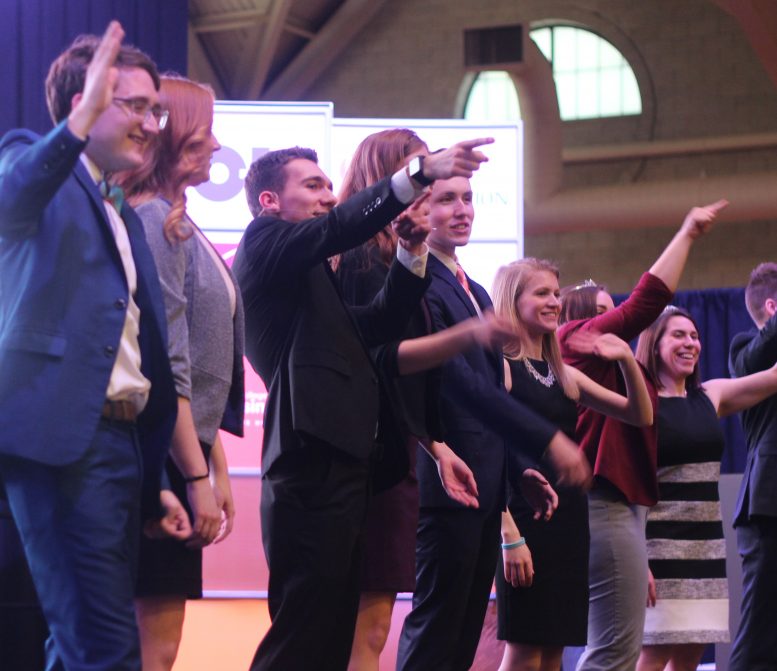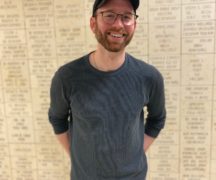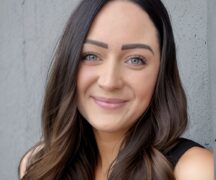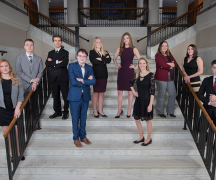By DAVID DUPONT
BG Independent News
Hatchling Sara Clark was on the brink of closing the deal.
Clark, of Bowling Green, was the last student entrepreneur to present her idea to a panel of alumni investors at The Hatch 2018 at Bowling Green State University Thursday night.
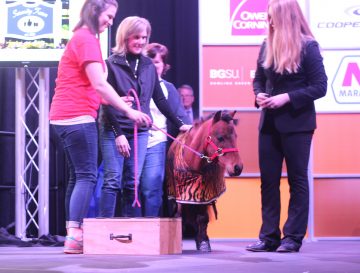
A miniature horse wears a Magnahalter that was created by Sara Clark (right).
Her invention was the Magnahalter, a halter using Velcro and magnets. The new halter would be easier for para-equestrians, and others to put a halter on a horse.
The investors though were more interested in the magnetic fastening than the halter itself, and they were putting the money behind that interest.
While Clark was looking for $7,600 to produce 100 prototype halters for a beta test, the investors were offering $20,000. But they’d claim 25-percent equity in the fastening technology. Clark paused. Could she consult with her mentor, Bob Venzel? She turned to where he was standing on the stage before 1,500 packed into the Perry Field House.
Then a voice rose from the crowd. There was a bit of commotion. Someone was offering her $10,000 with no stake. That someone turned out was retired banker Ed Reiter. That was the deal she accepted.
Investor Earle Malm mused at how the panel of investors lost out to “door number two.”
Kirk Kern, who was master of ceremonies, opined Clark might still want to talk to the investors to get input.
As Brian Sokol, who has participated in the Hatch since its inception, said at the beginning that though the program was modeled after the TV show “Shark Tank,” this was live, and that opened up the possibilities.
Like most of the other seven products presented, Clark, a major in intervention services in the College of Education and Human Development, drew on her personal experience and field of study to come up with her idea. She is a member of the BGSU equestrian team as well as an educator of people with special needs. The Magnahalter would also be of use to anyone with limited dexterity, even if that’s because of fingers numb from the cold.
The Magnahalter has already been used by a gold medalist on the USA para-equestrian team, and others on the team have expressed interest.
Clark has a patent pending on the halter.
This year featured eight proposals presented by 10 students. They were seeking both money and guidance to help their ideas get off the ground from a panel of six angel investors, all BGSU graduates.
Malm said The Hatch offered the students experience in presenting their ideas and raising the money to bring them to market.
What the investors could offer, beyond money, were the connections and advice, and the opportunity to have their projects go through incubation to further develop it before investment.
Investor Brian Sokol noted that while only 2 percent of start-ups funded by “angel investors’ were developed by female entrepreneurs, six of the 10 2018 Hatchlings are women.
Other 2018 Hatchlings and their ideas were:
Hannah Barth and Elyse Blau, both from the College of Education, presented the Pop-up Palace. They said their experience as student teachers in pre-school settings demonstrated that youngsters are not getting the hands-on play experiences that are necessary for their development. In its place, they are getting screen time.
The Pop-up Palace, which can easily be put up and taken down, has removable panels inside to both engage the child in play and teach them the basics.
While investor Dr. Michelle Drerup said as a mother she appreciated its portability, she was concerned about the stability of the product.
Michael Yourkvitch, an attorney, said they needed to look into intellectual property issues, and Malm suggested the real target market may be educational institutions.
The panel passed on investing in the product. The team did win the Eggy, the Hatch’s people’s choice award.
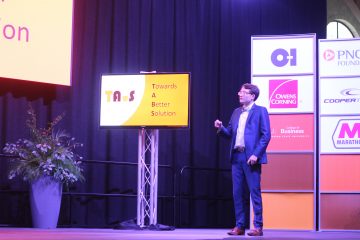
Isaac Rogers makes his presentation
Isaac Rogers, an Honors College student from the College of Business, is no stranger to The Hatch. A sophomore form Bowling Green, he’s attended every one. This time, though, he meant business.
His proposal was for TABS, an online game and social platform to help children with chronic diseases lead healthier lifestyles, including managing their medication.
Rogers said his own experience as someone with cystic fibrosis informed his creation of the device.
Sokol noted that in the field of medical apps there’s “a lot of competition in that space.”
Drerup also questioned whether there was another product on the market that served the same function.
Rogers said that no product matched all the services his provided.
The investors said he should incubate his idea further by working with Bravo Wellness.
Kristen Grom, a Visual Communications Technology major in the College of Technology, Architecture, and Applied Engineering, presented Power Play, a plush dog toy that can be controlled by a cell phone.
The toy is aimed at owners of dogs whose pets may not get as much exercise for a variety of reasons.
Drerup noted that with the recent rainy weather, she found herself standing inside a screen door, tossing a ball to her dog, and then closing the door until the dog retrieved it.
The Power Play, she said, would have come in handy.
The device would also have a camera included to allow dog owners to easily share their pet’s antics on social media. This is one way to attract millennials, who are 35 percent of dog owners, the largest group.
Investor Mark West said the toy’s drawback was also its strong point. The plush cover will wear out, he said. And that means customers will have to buy more.
The investors provided $5,000.
Rachel Poling, an applied health major from the College of Health and Human Services, presented Rehabiligait, a wearable device to monitor people with neurological disorders. How a person who’s had a stroke or suffers from dementia, Parkinson’s disease, Alzheimer’s or other neurological ailments, walks provides key information in how they are progressing.
Her device, which collects different and more specific data than devices such as Fitbit, will measure those factors, and communicate those to health care professionals. That may allow a patient to go in for additional physical therapy or tip off the doctor that the patient needs more advanced treatment.
When asked, Poling said that the idea that this may be used to predict the onset of these diseases is already being considered.
Poling was looking for $5,000, but the panel recommended the project be taken on by NextTech, a business development collaboration of BGSU, the University of Toledo, ProMedica, and Mercy Health.
Nick Bundy and Jacob Hauter, students in the College of Business, presented Saflee, a hybrid of a safe and disaster kit, that would allow people to have ready at hand both an emergency kit and essential documents and valuables in case they had to flee their homes.
The demand for Saflee, they said, will only increase as severe weather vents increase because of climate change.
The investors, however, opted to pass on the product.
Marikay Mester, a dietetics major in the College of Health and Human Services, presented Bloomzoa, an interactive nutrition app for children with dietary restrictions.
The game part would give the child a virtual pet with the same dietary needs as the child. The child would need to feed the pet the correct foods. Children could also use the app to determine what products they can and cannot eat. The app would be free for kids, though there would be a charge for the version aimed at parents.
Mester said she expects advertising by grocery stores to be her main source of revenues.
She was looking for $15,000 to help fund the development. She said she would be working with her brother and a team from DePaul University in Chicago to develop the app.
The investors offered her $5,000 with the proviso she also do the business incubation through The Hatch.
Olivier Ernst, who is pursuing his Master of Business Administration, presented Suppleo, a nutritional supplement dispenser for gyms and other places athletes work out.
Ernst said that the use of these supplements can improve health and fitness, and this dispenser would make the correct ones more readily available to athletes.
He has also contacted a Columbus company that manufactures vending machines about building a prototype.
The investors, however, seemed uncertain as to the revenue stream.
Nico Cottone, though, offered to consult with Ernst with the possibility that the investors might be interested once some questions were answered.

